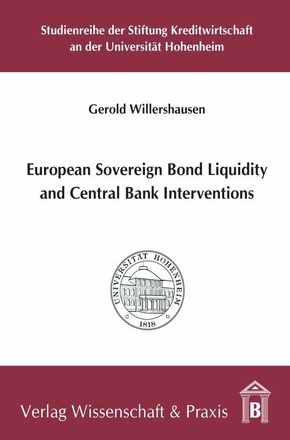European Sovereign Bond Liquidity and Central Bank Interventions. - Dissertationsschrift
| Verlag | Wissenschaft & Praxis |
| Auflage | 2018 |
| Seiten | 157 |
| Format | 15,0 x 21,0 x 1,1 cm |
| Gewicht | 275 g |
| Artikeltyp | Englisches Buch |
| Reihe | Studienreihe der Stiftung Kreditwirtschaft an der Universität Hohenheim 56 |
| ISBN-10 | 3896737422 |
| EAN | 9783896737427 |
| Bestell-Nr | 89673742A |
This work investigates liquidity in European sovereign bond markets. Liquidity in financial markets is often neglected when it is abounded, yet evaporating liquidity results in higher costs of transacting and lower information quality of financial markets. The analysis studies liquidity supplying trading strategies in debt markets and the impact of unconventional central bank policies on the time variations in market liquidity. Unconventional policies have been introduced since the global financial crisis and include asset purchase programs and long-term refinancing operations. The findings show that liquidity supply in European bond market declines during periods of financial stress and uncertainty. Moreover, expansive monetary policies and asset purchases can be associated with an improvement in market liquidity.
Inhaltsverzeichnis:
1 IntroductionMotivation - Research Outline - Structure of the Thesis2 Market LiquidityMarket Liquidity and Securities Prices - Market Participants - Liquidity Crises3 The European Government Bond MarketMarket Characteristics - Market Structure4 Short-Term ReversalsIntroduction - Literature Review - Data and Methodology - Results - Conclusion5 Liquidity and Unconventional Monetary PolicyIntroduction - Literature Review and Hypothesis Development - Data - Single Market Analysis - Spillovers and Flights - Robustness - Conclusion6 ConclusionSummary - OutlookBibliography
This work investigates liquidity in European sovereign bond markets. Liquidity in financial markets is often neglected when it is abounded, yet evaporating liquidity results in higher costs of transacting and lower information quality of financial markets. The analysis studies liquidity supplying trading strategies in debt markets and the impact of unconventional central bank policies on the time variations in market liquidity. Unconventional policies have been introduced since the global financial crisis and include asset purchase programs and long-term refinancing operations. The findings show that liquidity supply in European bond market declines during periods of financial stress and uncertainty. Moreover, expansive monetary policies and asset purchases can be associated with an improvement in market liquidity.

